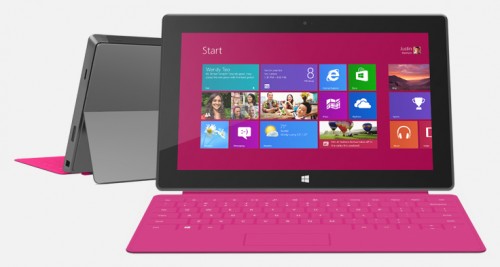This is a sponsored post. To find out more about sponsored content on Technology Bloggers, please visit our Privacy Policy.
With the launch of Windows 8, Microsoft has now entered the tablet market with the highly anticipated Microsoft Surface. Surface also marks the introduction of Windows RT, a version of Windows 8 designed specifically for ARM. Without further ado, here’s our verdict on the Microsoft Surface.
 Windows Surface is one of the new hybrid tablets that are emerging, blending touch tablet and traditional laptop functionality into one portable package. The main selling point is the keyboard, which can be effortlessly connected to Windows Surface, allowing for speedy word processing that is normally difficult on touch tablets. Being priced at the same level as the iPad retina display (£479 including keyboard), it’s clear to see who Microsoft have in their crosshairs.
Windows Surface is one of the new hybrid tablets that are emerging, blending touch tablet and traditional laptop functionality into one portable package. The main selling point is the keyboard, which can be effortlessly connected to Windows Surface, allowing for speedy word processing that is normally difficult on touch tablets. Being priced at the same level as the iPad retina display (£479 including keyboard), it’s clear to see who Microsoft have in their crosshairs.
Dimensions
With a 10.6-inch screen, the Surface is perfect for word processing, watching video and doing day to day tasks while remaining portable. It’s incredibly slim (9.3mm), being 1mm slimmer than the iPad retina display. Weighing in at 678g, this device is slightly heavier than other tablets and may cause discomfort when held in the hands for extended periods of time. That being said, there is a nifty kickstand which makes viewing Microsoft Surface extremely convenient.
Screen Quality
With many tablet manufacturers pushing screen resolution to the max, people were surprised to see that the resolution was somewhat lacking. With only 148ppi (pixels per inch) things definitely lack clarity when compared with the likes of the iPad 4 or Nexus 10.
Software
The biggest problem with Microsoft Surface is its distinct lack of apps. The marketplace is extremely barren when compared to the likes of the Apple of Android stores. Basic things like Facebook and Twitter don’t have their own apps and can only be accessed through ‘People Hub’. You should only rush to sell your iPad when this problem gets sorted.
Processor
Microsoft Surface is powered by a Tegra 3 chip, a highly praised processor that has powered the likes of the HTC One X+. The performance of the Surface is stable for the most part, however there have been many reports of long loading times for apps launching and lag while browsing. Not the most impressive thing about the Surface. However, it does do the job.
Connectivity
One of the best features of Microsoft’s Surface is its wealth of connectivity options, some of the best seen on a touch tablet. The Surface comes with a full sized USB port, Micro SD slot and HD video out. The only disappointment is the lack of mobile internet connectivity for the Surface, giving it limited capabilities when not connected to Wi-Fi.
Overall
This is a very promising product from Microsoft, however it still has many problems that need sorting out, in particular the lack of applications. I don’t think it is time to trade in/sell your stuff online just yet to fund the purchase, until Windows fix some of the problems with Surface.


